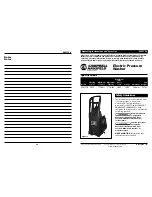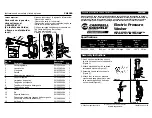
13
ENGLISH
EN
EN
IT
BG
CS
DA
DE
EL
ES
ET
FI
FR
HR
HU
LT
LV
NL
NO
PL
PT
RO
RU
SK
SL
SV
IT
BG
CS
DA
DE
EL
ES
ET
FI
FR
HR
HU
LT
LV
NL
NO
PL
PT
RO
RU
SK
SL
SV
TR
UK
TR
UK
AR
AR
7.2 Adjusting the detergent
To deliver detergent at the correct pressure, set the nozzle (E)
(where fitted) on " " or fit the detergent kit (C13) (where available)
as shown.
The quantity of detergent delivered is adjusted using the regulator (F).
7.3 Adjusting the working pressure (on models with this feature)
The regulator (G) is used to adjust the working pressure. The pres-
sure is shown on the pressure gauge (where fitted).
8
INFORMATION ON USE OF THE APPLIANCE (FIG.4)/PAGE 5
8.1 Controls
- Starter device (H).
Set the starter switch on (ON/I) to:
a) start the motor (in models without TSS device);
b) set the motor ready to start (in models with TSS device).
If there is a pilot light on the starter device, it should light up.
Set the starter device switch on (OFF/0) to stop the appliance.
If there is a pilot light on the starter device, it should go out.
- Water jet control lever (I).
Warning - danger!
During operation the appliance must be positioned as
shown in fig. 4 on a firm, stable surface.
8.2 Start-up
(see fig. 4)
1) Turn on the water supply tap fully.
2) Release the safety catch (D).
3) Depress the gun trigger for a few seconds and start up the appli-
ance using the starter device (ON/I).
Warning - danger!
Before starting up the appliance check that it is receiv-
ing water correctly; use of the appliance without water will
damage it. Do not cover the ventilation grilles when the
appliance is in use.
TSS models - In TSS models with automatic delivery flow cut-off system:
- when the gun trigger is released the dynamic pressure automati-
cally cuts out the motor;
- when the gun trigger is depressed the automatic drop in pressure
starts the motor and the pressure is restored after a very slight delay;
- if the TSS is to function correctly, all gun trigger releasing and
depressing operations must be at least 4-5 seconds apart.
To prevent damage to the appliance, do not allow it to
operate dry and check that it is properly supplied with water.
For models without TSS, to prevent damage to the appliance
due to an increase in water temperature, do not cut off the jet
of water for more than 5 minutes with the appliance running.
8.3 Stopping
1) Set the starter device switch on (OFF/0).
2) Depress the gun trigger and discharge the residual pressure
inside the pipes.
3) Engage the safety catch (D).
8.4 Restarting
1) Release the safety catch (D).
2) Depress the gun trigger and discharge the residual air inside
the pipes.
3) Set the starter device on (ON/I).
8.5 Storage
1) Turn off the water supply tap.
2) Discharge the residual pressure from the gun until all the water
has come out of the appliance.
3) Switch the appliance off (OFF/0).
4) Remove the plug from the socket.
5) Drain and wash out the detergent tank at the end of the working ses-
sion. To wash out the tank, use clean water instead of the detergent.
6) Engage the gun safety catch (D).
8.6 Refilling and using detergent
The detergent must be delivered using the accessories and by
the procedures described in point 7.3.
Use of a high pressure hose longer than the one originally supplied
with the appliance, or the use of an additional hose extension, may
reduce or completely halt the suction of detergent.
Fill the tank (B6) with highly biodegradable detergent.
8.7 Recommended cleaning procedure
Dissolve dirt by applying the detergent mixed with water to the
surface while still dry.
When dealing with vertical surfaces work from the bottom upwards.
Leave the detergent to act for 1-2 minute but do not allow the
surface to dry. Starting from the bottom, use the high pressure jet
at a minimum distance of 30 cm. Do not allow the rinse water to run
onto unwashed surfaces.
In some cases, scrubbing with brushes is needed to remove dirt.
High pressure is not always the best solution for good cleaning
results, since it may damage some surfaces. The finest adjustable
nozzle jet setting or the rotating nozzle should not be used on
delicate or painted parts, or on pressurised components (e.g. tyres,
inflation valves, etc..).
Effective cleaning depends on both the pressure and volume of the
water used, to the same degree.
9
MAINTENANCE (FIG.5)/PAGE 6
Any maintenance operations not covered by this chapter should be
carried out by an Authorised Sales and Service Centre.
Warning - danger!
Always disconnect the plug from the power socket
before carrying out any work on the appliance.
9.1 Cleaning the nozzle
1) Disconnect the lance from the nozzle.
2) Remove any dirt deposits from the nozzle hole using the tool (C1).
9.2 Cleaning the filter
Inspect the inlet filter (L) and detergent filter (if fitted) before each
use, and clean in accordance with the instructions if necessary.
9.3 Unjamming the motor (on models with this feature)
In case of lengthy stoppages, limescale sediments may cause the
motor to seize. To unjam the motor, turn the drive shaft with a
tool (M).
9.4 Refilling the oil
(for models with this feature)
Add oil through the intake hole to restore the correct level.
For oil characteristics, refer to the “Technical Data” table.
9.5 End-of-season storage
Treat the appliance with non-corrosive, non-toxic antifreeze before
storing it away for winter.
Put the appliance in a dry place, protected from frost.
10
STORAGE AND TRANSPORTATION (FIG. 5)/PAGE 6
Store the accessories as shown in fig. 5.
Transport the machine as shown in fig. 5.
EN - 7
Содержание DXPW004E
Страница 288: ...288 ...
Страница 289: ...289 ...
Страница 290: ...290 ...
Страница 291: ...291 ...
Страница 292: ...292 ...
Страница 293: ...293 ...
Страница 294: ...294 ...
Страница 295: ...295 ...














































